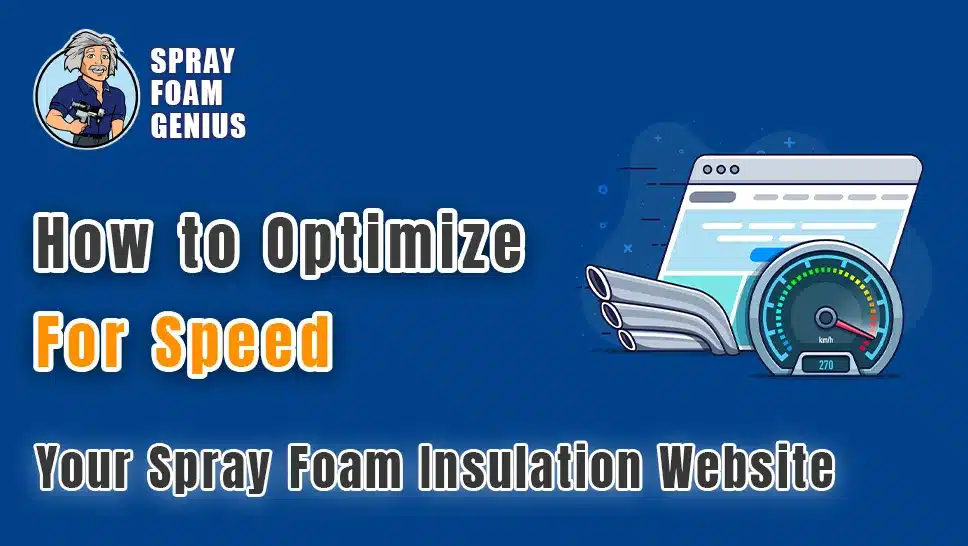
In the competitive field of spray foam insulation, having a fast and efficient website is essential. Speed is not just a technical detail; it directly impacts user experience, search engine rankings, and your bottom line. A slow-loading Spray Foam Insulation Website can lead to frustrated visitors, higher bounce rates, and missed opportunities. At Spray Foam Genius Marketing, we specialize in helping spray foam insulation contractors improve their online presence. This guide will walk you through key strategies to optimize your Spray Foam Insulation Website for speed, ensuring that your business remains competitive and accessible.
Why Website Speed Matters for Spray Foam Insulation Contractors
User Experience and Engagement
A fast website ensures that visitors can quickly access information about your spray foam insulation services. According to research by Google, 53% of mobile users abandon sites that take longer than 3 seconds to load (Source: Google). For spray foam insulation contractors, this means that a slow website could be causing you to lose potential customers who are looking for timely and reliable services.
SEO and Search Engine Rankings
Search engines like Google use page speed as a ranking factor. Websites that load quickly are favored in search results, making it easier for potential customers to find your services. A faster site not only improves your search engine rankings but also enhances your visibility online. Google’s PageSpeed Insights tool provides a detailed analysis of your site’s speed and offers recommendations for improvement.
Mobile Experience
With an increasing number of users browsing on mobile devices, optimizing for mobile performance is crucial. Mobile users are particularly sensitive to slow load times, and a sluggish site can lead to a poor user experience. A mobile-optimized, fast-loading website ensures that users have a positive experience regardless of the device they use, potentially increasing engagement and conversions.
How to Optimize Your Spray Foam Insulation Website for Speed

1. Choose a Reliable Hosting Provider
Your choice of web hosting provider is fundamental to your site’s performance. Here’s what to consider:
- Performance: Opt for a hosting provider with a reputation for high uptime and fast server response times. Look for providers that offer dedicated or VPS hosting if your site experiences high traffic.
- Scalability: Ensure that your hosting plan can handle traffic spikes. This is especially important if you anticipate seasonal increases in traffic or promotions.
- Support: Choose a provider with robust customer support that can quickly address any technical issues that arise.
2. Optimize Images and Media Files
Images and media files often contribute significantly to load times. Here’s how to optimize them:
- Compress Images: Use tools like TinyPNG or ImageOptim to reduce file sizes without compromising quality. Compressed images load faster and improve overall site performance.
- Choose the Right File Formats: For photos, use JPEG, and for graphics with fewer colors, use PNG. WebP is another format that offers excellent compression and quality.
- Implement Lazy Loading: Lazy loading delays the loading of images and videos until they are in the viewport. This can significantly reduce initial load times and improve user experience.
3. Minimize HTTP Requests
Each element on a webpage requires an HTTP request, which can slow down your site. To minimize HTTP requests:
- Combine Files: Merge CSS and JavaScript files to reduce the number of requests made by the browser. Fewer files mean fewer requests, which can speed up page loading.
- Use CSS Sprites: Combine multiple images into a single image sprite. This reduces the number of image requests and can improve load times.
- Remove Unnecessary Plugins: Evaluate and remove any plugins or scripts that are not essential to your site’s functionality. Excessive plugins can slow down your site and introduce security vulnerabilities.
4. Leverage Browser Caching
Browser caching allows your site to store files in a visitor’s browser, reducing load times for repeat visits:
- Set Expiration Dates: Configure your site to set expiration dates for cached files. This allows browsers to store files for a specified period, reducing the need for repeated downloads.
- Utilize Tools: Tools like Google Page Speed Insights can help you configure caching settings effectively and identify opportunities for improvement.
5. Enable Gzip Compression
Gzip compression reduces the size of your website’s files before they are sent to the user’s browser:
- Activate Gzip: Enable Gzip compression on your web server to reduce the size of HTML, CSS, and JavaScript files. This decreases the amount of data transferred and improves load times.
- Verify Compression: Use online tools to check that Gzip is properly enabled and compressing your files as intended.
6. Optimize Your Code
Efficient, clean code contributes to faster website performance:
- Minify CSS and JavaScript: Remove unnecessary characters, spaces, and comments from your code to reduce file sizes. Tools like UglifyJS and CSSNano can help with minification.
- Use Asynchronous Loading: Implement asynchronous loading for JavaScript files to prevent them from blocking the rendering of your page. This ensures that your page loads quickly and efficiently.
- Reduce Redirects: Minimize the use of redirects as each redirect adds an additional HTTP request and can slow down your site.
7. Implement Content Delivery Networks (CDNs)
A Content Delivery Network (CDN) distributes your site’s files across multiple servers around the world:
- Improve Load Times: CDNs deliver content from servers closest to the user’s location, reducing latency and improving load times.
- Enhance Reliability: CDNs can handle high traffic loads and ensure consistent performance during peak times, reducing the risk of downtime.
8. Monitor and Test Website Performance
Regular monitoring and testing are essential for maintaining optimal website speed:
- Use Performance Testing Tools: Tools like Google PageSpeed Insights, GTmetrix, and Pingdom provide valuable insights into your site’s performance and highlight areas for improvement.
- Conduct Regular Audits: Regularly audit your website to identify and address any speed-related issues. This proactive approach helps maintain optimal performance over time.
9. Optimize Your Database
A well-maintained database contributes to faster website performance:
- Clean Up Data: Regularly clean your database by removing unnecessary data such as post revisions, spam comments, and old data. This reduces the database’s size and improves performance.
- Optimize Queries: Review and optimize your database queries to enhance efficiency. Well-optimized queries run faster and reduce the load on your server.
10. Implement Mobile Optimization Strategies
Ensure that your website is fully optimized for mobile devices:
- Responsive Design: Use responsive design techniques to ensure that your website adapts to various screen sizes and devices. A responsive site provides a consistent user experience across all devices.
- Test Mobile Performance: Regularly test your website’s performance on mobile devices to identify and address any issues. Tools like Google Mobile-Friendly Test can help assess mobile performance.
Contact Us to Enhance Your Website’s Performance
Optimizing your spray foam insulation website for speed can have a significant impact on your business. A faster website improves user experience, boosts SEO, and enhances mobile performance, ultimately leading to more conversions and satisfied customers. At Spray Foam Genius Marketing, we offer expert services to help you achieve these goals.
Ready to improve your website’s speed and performance? Contact us today to learn how our SEO, website development, and optimization services can benefit your business. Call us at 877-840-FOAM for USA and 844-741-FOAM for Canada visit our website at sprayfoamgeniusmarketing.com, or email us at [email protected] to get started.
- 5 Google My Business Hacks to Double Your Leads for Spray Foam Insulation Contractors - January 14, 2025
- Why Spray Foam Contractors Cannot Ignore Reputation Management in 2025 - January 13, 2025
- Local SEO Secrets Every Spray Foam Contractor Must Know to Win in 2025 - January 13, 2025

